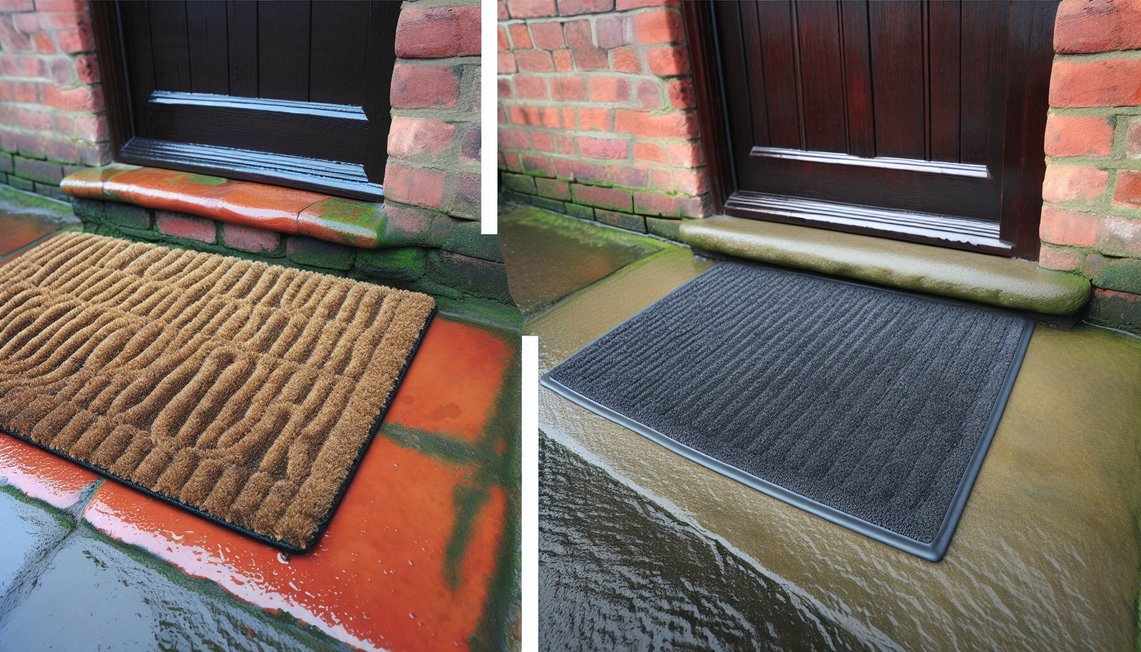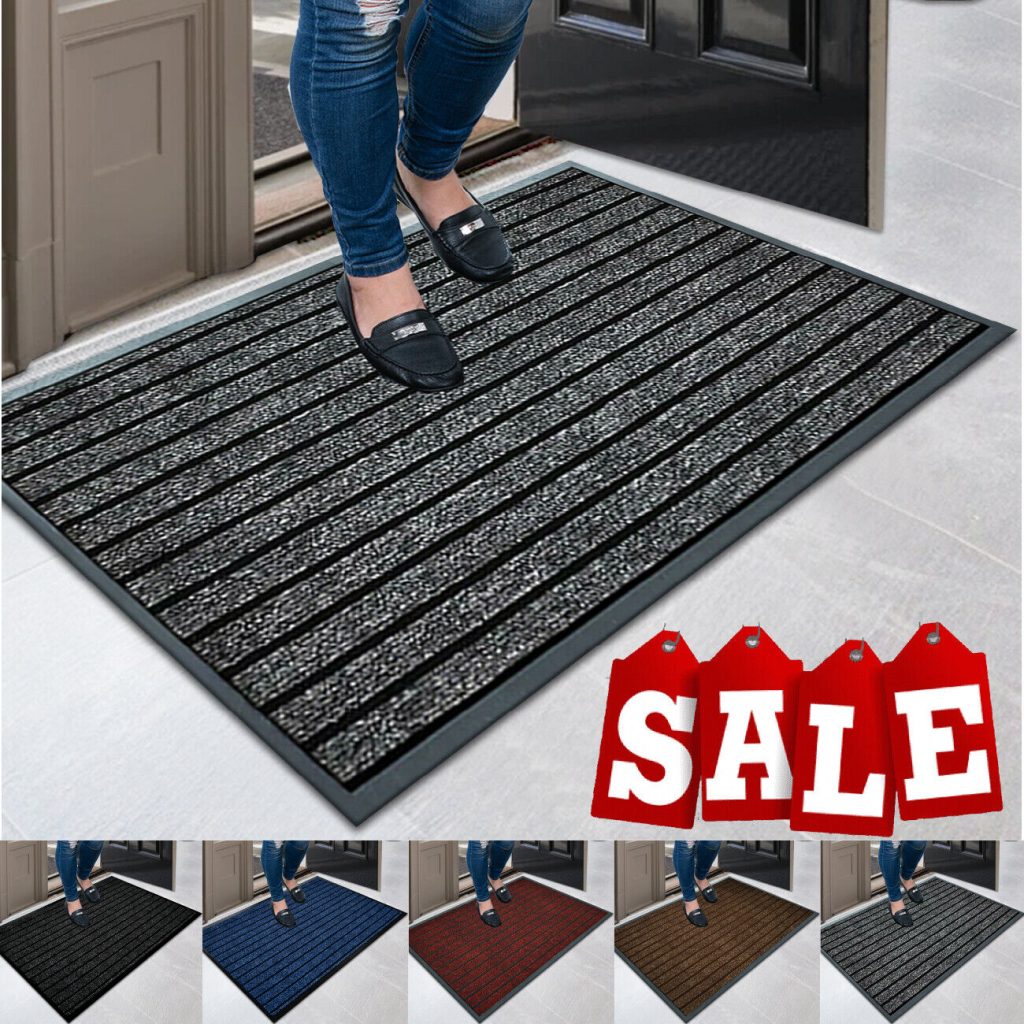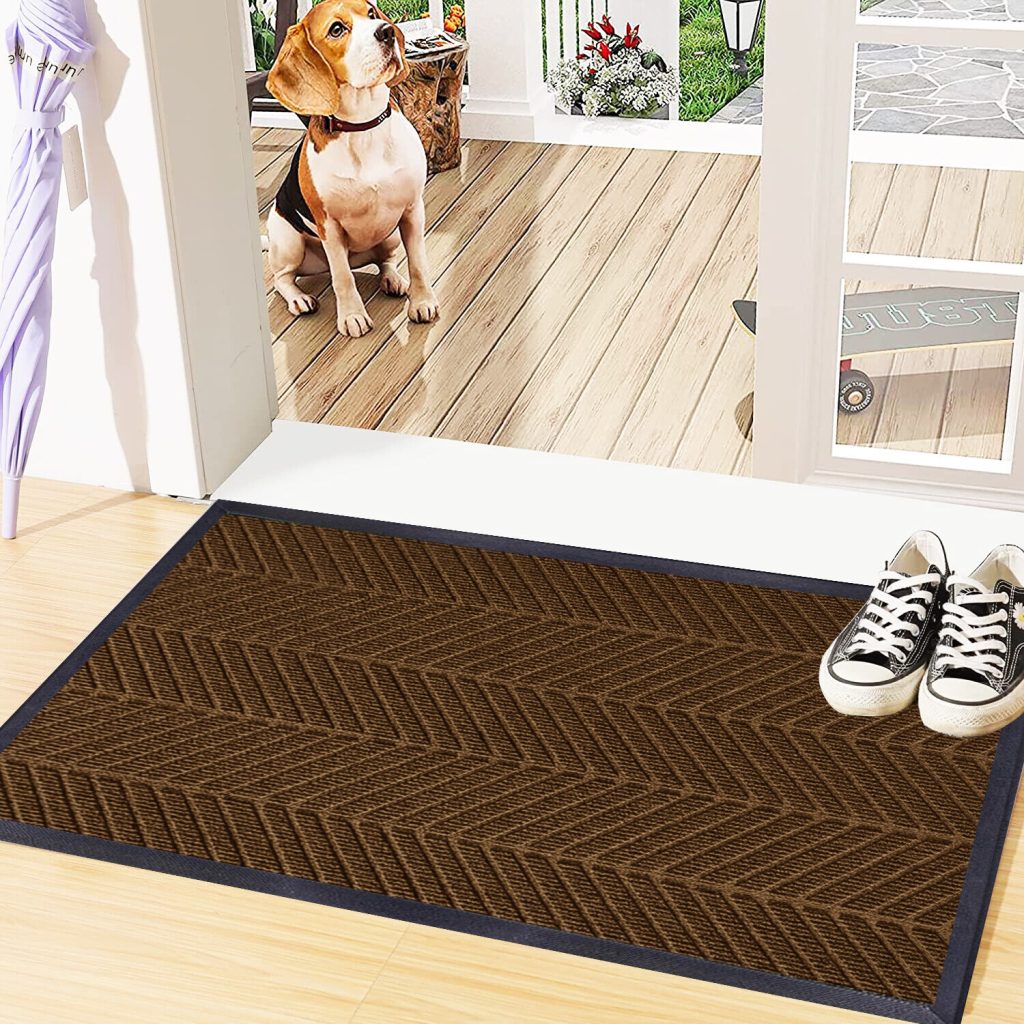Choosing the right doormat is essential for maintaining a clean, safe, and inviting entryway, especially in the UK where weather conditions can be unpredictable. A well-selected doormat not only traps dirt and moisture but also sets the tone for your home. This comprehensive guide will help you understand the key differences between heavy-duty and standard doormats, allowing you to select the best fit for your home and lifestyle.
Understanding the Key Differences: Heavy-Duty vs. Standard Doormats
Heavy-duty doormats are specifically engineered for rigorous use and high-traffic areas, offering superior durability and exceptional dirt-trapping capabilities. They are a robust solution for homes exposed to significant outdoor elements or heavy footfall. In contrast, standard doormats typically cater to lighter foot traffic, focusing more on aesthetic appeal and basic functionality, often suitable for more sheltered or indoor environments.
What Defines a Heavy-Duty Doormat?
- Purpose-Built Durability: Designed to withstand the elements, extensive use, and abrasive dirt.
- Superior Dirt and Moisture Trapping: Highly effective at scraping off mud, grit, and absorbing moisture from shoes.
- Ideal for Outdoor and Commercial Use: Perfect for exposed front doors, back doors leading to gardens, workshops, or even commercial entryways.
Characteristics of Standard Doormats
- Lighter Use: Suited for indoor or sheltered entryways where foot traffic is moderate and dirt accumulation is minimal.
- Focus on Aesthetics: Often feature a wider variety of designs, colours, and textures to complement interior decor.
- Basic Functionality: Provides a degree of dirt and dust trapping, but not designed for heavy-duty cleaning.
The primary distinctions between these two types of mats lie in their construction, the robust materials used, and their intended usage, which directly impacts their longevity and effectiveness in diverse UK settings.
Material Breakdown: What Makes Each Doormat Durable and Effective?
The materials from which a doormat is constructed are crucial for determining its effectiveness, longevity, and ease of maintenance – all key considerations, particularly given the damp, variable UK climate.
Heavy-Duty Doormat Materials
Heavy-duty mats are often crafted from resilient materials like natural coir, durable rubber, tough polypropylene, or a strategic combination of these. Each material brings specific benefits:
- Coir Fibres: Derived from coconut husks, coir is renowned for its stiff, abrasive bristles, making it exceptionally good at scraping mud, dirt, and debris from footwear. It’s a classic choice for outdoor mats in the UK due to its natural, rustic appearance and excellent scraping ability.
- Rubber: Often used for backing, rubber provides superior slip resistance, crucial for safety on wet or tiled outdoor surfaces. It also offers waterproofing, preventing moisture from seeping through to your flooring. Full rubber mats are incredibly durable and easy to clean.
- Polypropylene: A synthetic fibre that offers excellent weather resistance, quick drying properties, and is remarkably easy to clean. Polypropylene mats are often highly effective at trapping both dirt and and moisture, making them ideal for exposed outdoor areas.
These robust materials ensure heavy-duty mats generally require less frequent replacement, even when exposed to adverse weather conditions, providing long-term value for outdoor use.
Standard Doormat Materials
Standard mats commonly feature softer materials like nylon, cotton blends, or polyester. While these materials offer comfort and a broader range of decorative options, they prioritise indoor suitability and aesthetics rather than hardcore dirt trapping:
- Nylon and Polyester: These synthetic fibres are durable for indoor use, offer good colour retention, and can effectively trap finer dust and particles. They are often found in indoor dirt trapper mats.
- Cotton Blends: Known for their absorbency and softness underfoot, cotton mats are comfortable but less effective against heavy mud and moisture, and typically not suitable for prolonged outdoor exposure.
Durability & Weather Resistance: Which Doormat Withstands the Elements Best?
In the UK, where rain, frost, and mud are common occurrences, a doormat’s ability to withstand the elements is paramount. This is where the distinction between heavy-duty and standard mats becomes particularly clear.
Heavy-Duty Mats: Built for British Weather
Heavy-duty doormats are meticulously engineered to brave the challenging UK weather. Their construction and materials are designed to resist rain, frost, mud, and even UV degradation from sunlight. Materials like rubber and polypropylene are often UV-resistant and quick-drying, preventing issues such as mould, mildew, and premature degradation that can plague less robust mats. Their dense fibres and robust backing mean they remain effective and intact even after prolonged exposure to the elements.
For UK outdoor use, heavy-duty doormats like this Heavy-Duty Dirt Trapper Doormat offer superior longevity, effectively tackling muddy boots and wet shoes from the garden or street.
Standard Mats: Best for Sheltered Spaces
Conversely, many standard doormats are not waterproof or weatherproof. They are better suited for covered entryways, conservatories, or interiors where they are shielded from direct exposure to rain and harsh conditions. Prolonged contact with water or extreme temperatures can cause rapid wear, fading, and even structural damage to standard mats, making them unsuitable for exposed outdoor placements.
Sizing Your Doormat for UK Entryways: Practical Tips for a Perfect Fit
A properly sized doormat is crucial for both functionality and aesthetics. It should be large enough to comfortably accommodate foot traffic, allowing for a couple of steps to effectively clean shoes, yet fit within the doorway space without obstructing door movement. Getting the right size is especially important in UK homes where entryway dimensions can vary significantly.
Measuring for Your UK Doormat
- Door Width: Measure the width of your door opening. For optimal coverage, your doormat should ideally be at least as wide as your doorway, with a few extra inches on each side if space allows. This ensures ample stepping space.
- Depth: Consider the depth of your entryway. A deeper mat allows for more foot scrapes, leading to cleaner floors indoors.
- Door Clearance: Always check your door’s clearance – ensure the mat isn’t too thick, preventing the door from opening and closing smoothly.
Common UK Door Sizes and Recommended Mat Dimensions
- Standard Single Front Doors (typically 700-800mm wide): A doormat around 60 x 90 cm (24 x 35 inches) works exceptionally well, providing sufficient coverage without overpowering the space.
- Larger Single Doors or Patio Doors: For wider doors, consider mats around 90 x 120 cm (35 x 47 inches).
- Double Doors or Grand Entryways: These benefit from larger mats, typically 90 x 150 cm (35 x 59 inches) or even bespoke sizes to ensure full coverage and a welcoming appearance.
Always account for any architectural features such as porch overhangs or recessed entryways, as these might influence the amount of dirt accumulation and optimal mat placement.
Style and Functionality: Enhancing Your Entryway’s Look and Usefulness
Beyond its primary role of trapping dirt, a doormat serves as an important design element, contributing significantly to your home’s exterior aesthetic and inviting appeal. Heavy-duty mats, while prioritising practicality and performance, certainly don’t have to sacrifice style.
Balancing Aesthetics with Practicality
- Complement Your Home’s Architecture: For traditional UK brickwork or stone houses, a classic coir mat or one with subtle, natural patterns can blend beautifully. For modern renders or contemporary homes, sleek designs in neutral tones like charcoal, black, or grey often work best.
- Personalised Touches: Consider doormats with welcoming messages, family names, or unique designs to add a personal and homely touch, making your entryway more inviting.
- Colour and Pattern Choices: While bright colours might seem appealing, darker, neutral tones (greys, browns, deep blues) are often more practical for an outdoor mat as they hide trapped dirt more effectively. Subtle patterns can add interest without being overwhelming.
- Low-Profile Designs: To minimise tripping hazards and ensure door clearance, select low-profile designs that still maintain effective dirt-scraping capabilities. Many heavy-duty options are designed to be thin yet highly effective.
By carefully balancing aesthetic preferences with functional requirements, your doormat can serve as both a highly practical item for maintaining cleanliness and a stylish feature that enhances your home’s curb appeal, making it a truly inviting focal point.
Comparison Table: Heavy-Duty vs. Standard Doormats
To help you make an informed decision, here’s an at-a-glance overview of the key features differentiating heavy-duty and standard doormats, considering their performance and suitability for various applications in a UK context.
| Feature | Heavy-Duty Doormats | Standard Doormats |
|---|---|---|
| Materials | Coir, dense rubber, robust polypropylene, often blended for maximum performance | Nylon, cotton blends, polyester, finer synthetic fibres |
| Durability & Lifespan | Exceptional; long-lasting even with constant use and exposure to harsh conditions | Moderate; shorter lifespan, especially if exposed to moisture or heavy wear |
| Weather Resistance | Excellent – highly resistant to water, frost, mud, and UV degradation. Quick-drying. | Poor to moderate; typically not waterproof or weatherproof, prone to damage from elements |
| Dirt/Moisture Handling | Superior – highly efficient at scraping and trapping deep mud, grit, and absorbing significant moisture. | Moderate – suitable for trapping dust, fine dirt, and light moisture, but not heavy mud. |
| Maintenance | Generally easy to clean; often can be hosed down, brushed, or even machine washed (check labels). Quick to dry. | |
| Slip Resistance | High; typically features robust rubber or non-slip backing for safety on wet surfaces. | Varies; some have basic non-slip backing, others may not be as secure. |
| Cost Range (UK) | Generally higher initial investment, typically £20 – £60+, offering greater long-term value. | Lower initial cost, typically £10 – £30, but may require more frequent replacement. |
| Typical Use | Outdoor entryways, high-traffic residential areas (e.g., front doors, back doors leading to gardens), commercial spaces. | Indoor entryways, sheltered porches, light-traffic areas, decorative purposes. |
| Aesthetic | Functional, rugged, robust look, often in practical colours. | More variety in design, colour, texture; often softer and more decorative. |
Frequently Asked Questions About Heavy-Duty and Standard Doormats
Q: How often should I clean a heavy-duty doormat?
A: For optimal performance, heavy-duty doormats should be cleaned at least once a month, or more frequently during wet and muddy seasons (e.g., autumn and winter in the UK). Simply shake off loose dirt, then hose it down thoroughly or machine wash it if the mat’s care label permits.
Q: Can I use a heavy-duty mat indoors?
A: Yes, you certainly can. If you desire superior dirt and moisture trapping inside your home, a heavy-duty mat can be very effective. However, be mindful that some heavy-duty options, particularly those made with stiff coir or rubber, can feel rougher underfoot compared to softer indoor mats.
Q: Are heavy-duty doormats more expensive?
A: Generally, heavy-duty doormats have a higher initial purchase price due to their robust materials and construction. However, their superior durability, extended lifespan, and reduced need for frequent replacement often make them a more cost-effective choice in the long run.
Q: What size doormat suits a UK front door?
A: For standard UK front doors, which typically measure around 700-800mm in width, a doormat between 60x90cm and 90x120cm is usually ideal. It’s always best to measure your specific doorway carefully before purchasing to ensure a perfect fit that allows the door to open freely.
Q: Which mat is better for rainy UK weather and muddy conditions?
A: Without a doubt, heavy-duty doormats crafted from water-resistant and highly abrasive materials like coir, rubber, or polypropylene provide far better protection against the mud and moisture prevalent in the British climate. They are specifically designed to scrape and trap wet debris effectively.
For a practical, durable choice tailored to UK entryways, consider the RugStars Heavy-Duty Dirt Trapper Doormat. It combines excellent weather resistance, a secure non-slip backing, and the convenience of being washable, making it an ideal solution for the demands of the British climate.
Making an informed decision between heavy-duty and standard doormats ensures your home remains clean, safe, and welcoming all year round, regardless of the weather outside. Choose the mat that best fits your specific lifestyle, the local climate, and your personal style preferences.



